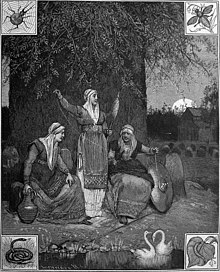Norns
The Norns ( old Norse nornir ) are fate-determining female beings in Norse mythology , some of whom are said to have descended from gods, others from dwarfs or elves . Within the Indo-European religions and mythologies, there is a relationship with the Roman Parzen and the Greek Moiren .
The Norns in the Edda
Three women of fate are named: They are called Urd (fate), Verdandi (that which is becoming) and Skuld (guilt; that which should be). Their names are considered to be the Nordic counterparts of common medieval conceptual concepts of the time in the form of personifications of the past (Urd), present (Verdandi) and future (Skuld). Even if their names are young, they seem to go back to an old Germanic idea of a nameless trinity of women of destiny.
After Völuspá they live at the root of the world ash Yggdrasil at the Urd-spring , the source of fate, after the Norne, Urd is named. They direct the fate of men and gods.
|
Ask veit ek standa, |
I know an ash tree |
According to the Gylfaginning in the Snorra-Edda , the tree is not preserved by fog, but the Norns tend it:
“Enn er þat says, at nornir þær, er byggja við Urðarbrunn, taka hvern dag vatn í brunninum ok með aurinn þann, er liggr um brunninn, ok ausa upp yfir askinn, til þess at eigi skuli limar hans tréna eða fú. En þat vatn er svá Heilagt, at allir hlutir, þeir er þar koma í brunninn, verða svá hvítir sem hinna sú, er skjall heitir, er innan liggr við eggskurn. "
“It is also said that the Norns who live at the Urda Fountain draw water from the fountain every day and pour the mud around the spring over the ash so that its branches do not wither or rot. This water is so sacred that all things that get into that spring become as white as the skin that is called Skjall and that sits on the inside of the eggshell. "
In addition, such Norns are mentioned who help mothers with childbirth: In Fafnismál Sigurd asks the dragon Fafnir:
|
Segðu mér, Fáfnir, |
Let yourself be asked, Fafnir, |
Subsequently, they were given the task of announcing the child's life span. Here they generate the personal fate (Latin: fate) of the individual. In the Edda it says:
|
Nótt varð í bæ, |
It was night in the homestead, |
"Skuld" (literally: guilt, "Skal": should) is also known as the name of a Valkyrie .
|
Sá hún valkyrjur |
I saw Valkyries |
There are similar women of fate in Greek ( Moiren ), Roman ( Parzen ) and Slavic mythology ( Zorya ).
Another variant is that the Norns do not determine fate as such, but that good Norns allocate good and bad Norns assign evil.
"Góðar nornir ok vel ættaðar skapa góðan aldr, en þeir menn, er fyrir ósköpum verða, þá valda því illar nornir."
“Good Norns of a noble sex bring a good life; but those who suffer misfortune owe it to the wicked Norns. "
Two swans swim in the Urdquelle, all of which are white swans:
"Fuglar tveir fæðast í Urðarbrunni. Þeir heita svanir, ok af þeim fuglum hefir komit þat fuglakyn, he svá heitir. "
"There are two birds called swans living in the Urda Fountain, and it is from them that the species of bird with this name comes from."
Often the Norns are confused with the Valkyries . Sometimes they are also mixed with the guardian spirits Fylgja and the wise women volur and spåkonur .
reception

Due to the imponderables inherent in fate, the Norns are considered to be the expression of the ambivalent aspect of the so-called mother archetype in the sense of the analytical psychology of Carl Gustav Jung .
In the prelude to Richard Wagner's Götterdämmerung , the last part of his tetralogy The Ring of the Nibelung , the Norns play an essential role. They recall what happened in the three previous evenings, the present and finally, while the rope of fate breaks, from which they read the runes as if in a dream , the near end of the gods, the onset of the twilight of the gods ( Ragnarök ).
Contemporary metal bands, e.g. B. Brothers of Metal , pick up the Norns and other themes of Norse mythology in their pieces.
The Norns also incorporate various fantasy works that take up Nordic mythology into their plot, for example the novel trilogy The Secret of the Great Swords by Tad Williams or the manga series Oh! My Goddess and Detective Loki . But there are also allusions to Nordic mythology in the works Throne of Glass and the Kingdom of the Seven Courts .
literature
- François-Xavier Dillmann: Norns. In: Reallexikon der Germanischen Altertumskunde (RGA). 2nd Edition. Volume 21, Walter de Gruyter, Berlin / New York 2002, ISBN 3-11-017272-0 , pp. 388-394.
- Klaus von See , Beatrice La Farge, Wolfgang Gerhold, Debora Dusse, Eve Picard, Katja Schulz: Commentary on the songs of the Edda . 4th volume: Heldenlieder , Winter, Heidelberg 2004, ISBN 978-3-8253-5007-9 .
- Hildegard Kirschenknapp: Parzen and Norns. The poetic formation of the mythological figures of fate between the Enlightenment and Expressionism . Lang, Frankfurt am Main et al. 2000, ISBN 3-631-36024-X (= European university publications . Series 1, volume 1750, also dissertation , University of Düsseldorf 1999).

